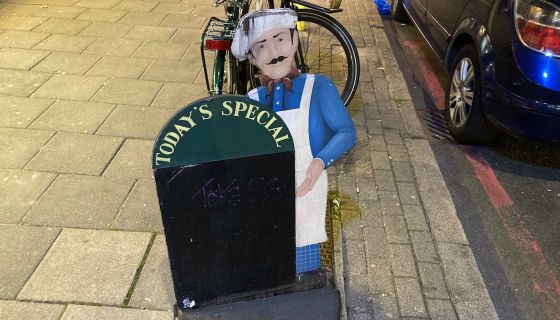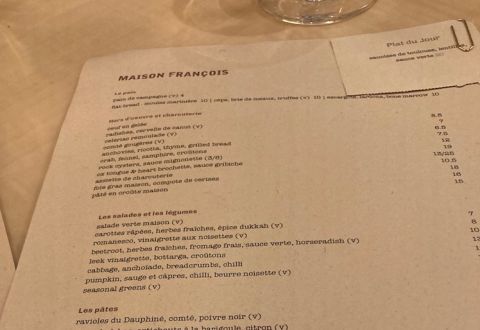The sign outside the pide (Turkish flatbread) restaurant on London’s Holloway Road set me thinking.
It was headed ‘Today’s Special’ but where a list of specials should have appeared it was just blank. The sign, about a foot tall, was probably taken out of the restaurant every morning, placed on the pavement while it was open for business, and then taken in after the last customer had departed. Specials seem no longer to be important or even a fixture on the menu of modern restaurants.
But that is not how I remember ‘specials’. As a restaurateur in the 1980s, I regarded them as an absolute fixture on our menus. I can still remember calling down from my office on the fourth floor to the kitchen in the basement of our restaurant just before noon to find out what were the lunchtime specials. There would always be a soup, a salad, at least two fish dishes and, during the game season, invariably a game dish.
Then it was a hunt for the person with the neatest handwriting who would have to be persuaded to stop what they were doing to write out the specials on the master menu, which was then printed and chopped into four before being rushed down to the restaurant. There, these lists of the specials were attached via a paper clip to the 60-odd menu cards before a final check that, for example, all the prices were correct. The same process was repeated just before we opened for dinner as the lunch specials had invariably sold out.
The specials card was an invaluable adjunct to our menu. It meant that the chefs never got bored and that the kitchen need only to prepare two main-course fish dishes as a fixture since the other two would be offered as specials. These could always be counted on as offering the freshest fish, delivered that morning. And by printing the details of the specials alongside their price we managed to avoid the infuriating phenomenon of a waiter recounting the details of the specials but not their price.
For many years, having swapped restaurateur for restaurant reviewer, my attention would invariably focus on what was on any restaurant’s specials, however they were presented. I never believed that what was on offer on these were ingredients that the chef had purposely bought in because they were inexpensive (a line strongly pedalled when you look up ‘specials’ on the internet). They were, in my mind, the freshest ingredients; dishes that the kitchen felt proud to be cooking; dishes that were special in that their number was strictly limited; and they revealed the true nature of the restaurant. They were indeed special. They were not to be missed – dishes that were here today but gone tomorrow.
Specials started to disappear in the 1990s. That was the beginning of the era of the ‘celebrity chef’ who was not to be argued with in such matters. He – and it was almost always a he – would have wanted a menu that was finished to his liking – without interference from a restaurateur. The menu was to be presented as the chef’s creation, his own work.
This situation was exacerbated by the appearance of chef’s tasting menus, which, when they first appeared, offered very little in the way of choice. Today, exemptions are made for vegetarians, for vegans, for anyone at all with a food allergy. But it was not always thus and such a hard-line approach would have left no room for the inclusion of specials. At least Maison François in London’s St James’s features one special in the top right-hand corner of its menu (see below).
For confirmation, or otherwise, I turned to two current practitioners. Will Beckett, one of the two founders of Hawksmoor restaurants, and Tim Hughes, the executive chef of Caprice Group restaurants, which include J Sheekey and the many iterations of The Ivy.
Beckett was the more positive of the two.
‘Specials are not a permanent feature of the Hawksmoor menu and I think that immediately post-COVID we, like most restaurants, have stuck to the tried and tested main menu. Having said that, I think we often have specials around new restaurant openings – dishes which are often a "download" of a lot of intensive creativity, usually focused around our Cooks Room in Borough, which is the combination of a private dining room and a test kitchen.
‘For the most part, specials are produce-driven – someone we trust will give us a call and explain that they have something extra-special which is there for the customer to try. So last weekend at our restaurants in Borough, Spitalfields and Air Street there was a dish of Torbay prawns in a classic cocktail sauce, with a description of how these beauties are caught.’
Hughes was slightly more sceptical about the future of specials.
‘Labour has become expensive and tricky-to-find, which is leading to shorter menus. Also finding staff with handsome handwriting is proving increasingly difficult. But I believe that the biggest obstacle to the re-emergence of specials is that everybody today is pressed for time: the kitchen as well as the guest. And as the customer does not have the actual time to take in what’s on the list of specials, the kitchen won’t bother with them.’
With the advent of the daily printed menu, ‘specials’ are obviously being incorporated there. But now that restaurants are finally emerging from the pandemic, I think the time is right for the return of ‘specials’.















